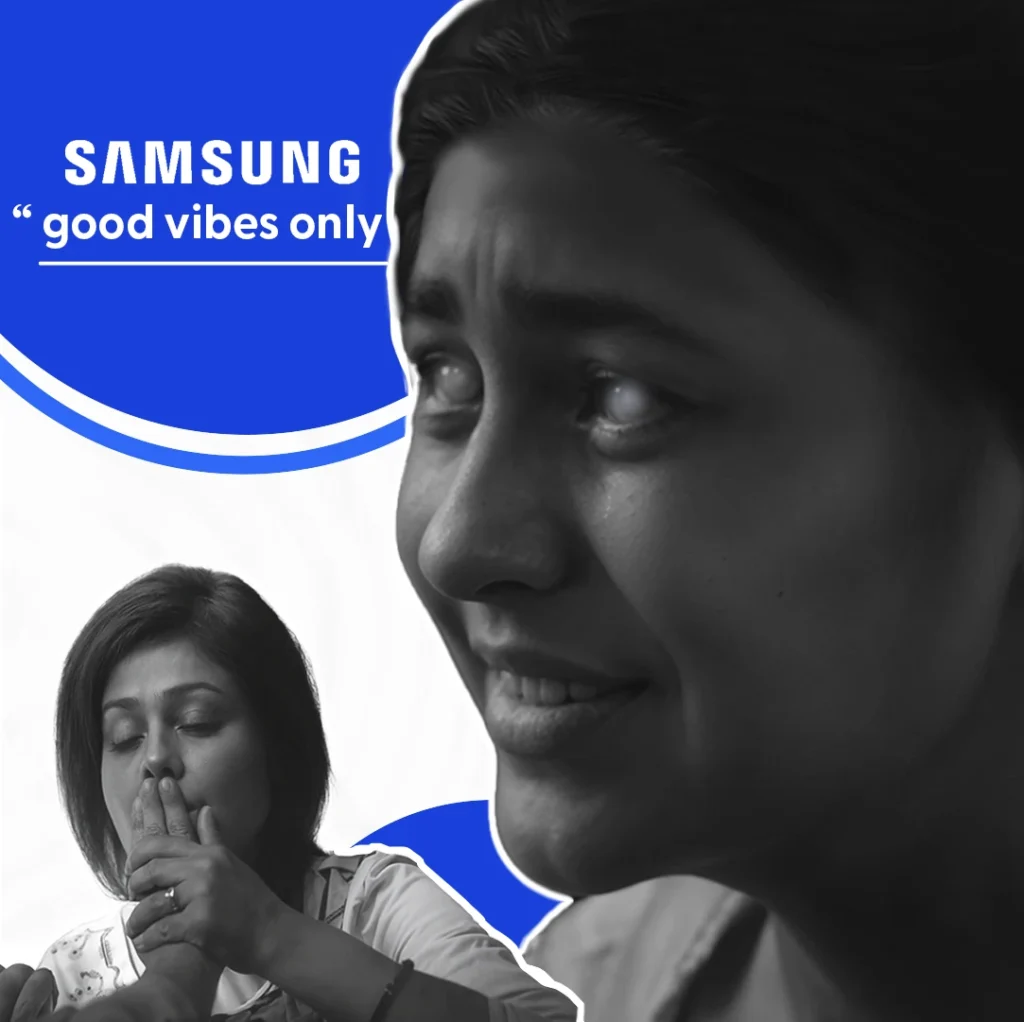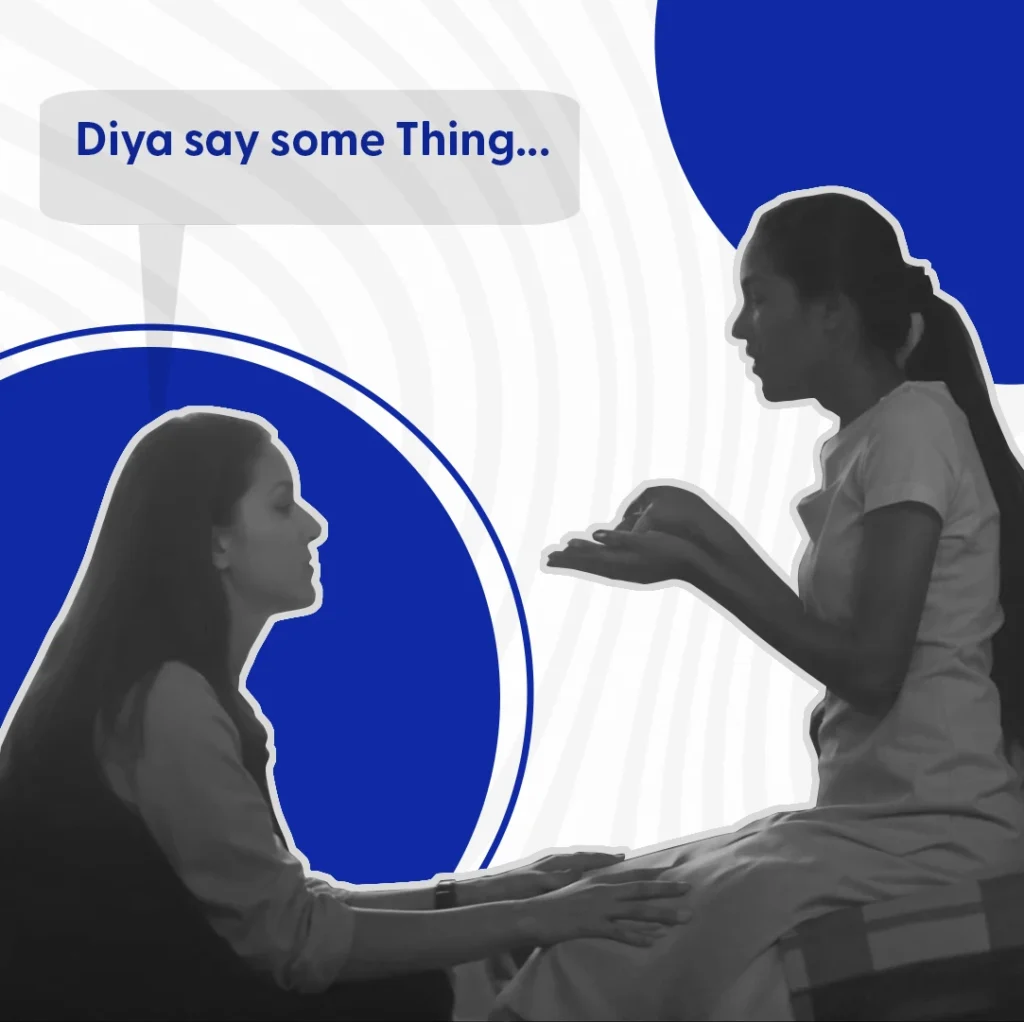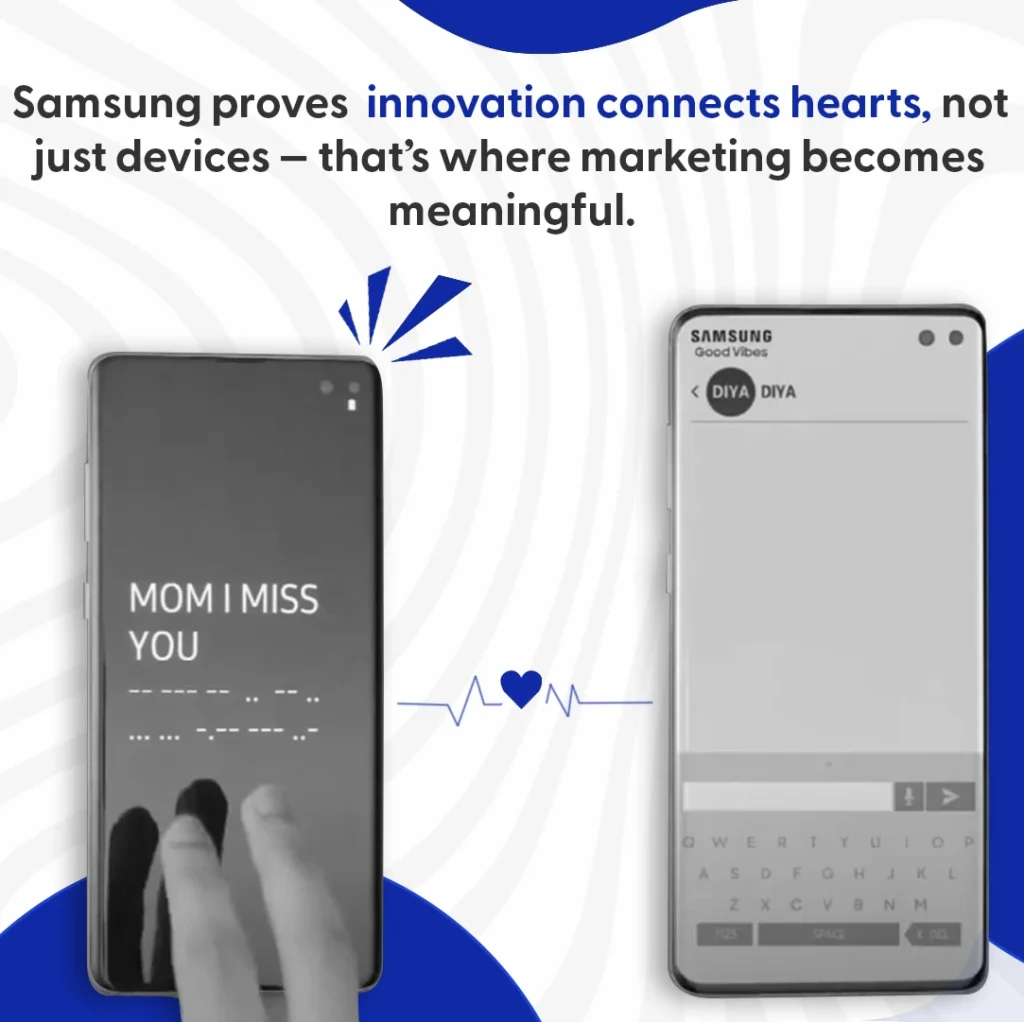
14 Aug 2025
How the Samsung Good Vibes Campaign Redefined Brand Storytelling
What if digital marketing was more than a means to sell, but a medium to empower the unseen, unheard, and too-often overlooked? In 2019, Samsung India did something radical by creating the Samsung Good Vibes campaign around people who can neither see nor hear. They launched Good Vibes, a tech-driven, soul-led campaign that did not use aesthetic visuals or celebrity endorsements — only vibrations, silence, and a deeply felt impact.
Samsung Good Vibes wasn’t trending over trend. It was about purpose-driven marketing and connection — particularly to India’s deafblind community, the majority of whom live in complete isolation. And in the process, Samsung reminded the marketing universe that brand storytelling doesn’t have to scream. It just needs to matter.
Table of Contents
Designing for the Unseen: Samsung Marketing Strategy with Good Vibes

There are more than 500,000 deafblind people in India. For many, communication is almost impossible — they can’t hear, they can’t see, and they usually have no way to express themselves or comprehend others. From a traditional digital marketing campaign perspective, this is not a “profitable audience”.There is no data, no funnel, and no engagement metrics that justify the efforts.
However, Samsung’s focus wasn’t just on the marketplace. They saw a gap and decided it could be filled with innovation.
Good Vibes is a smartphone app that enables two-way communication between deafblind users and their caregivers. There are Morse-code-based vibrations on the interface for the deafblind, and a text-based visual interface for the caregiver. Through this, the phone becomes a medium of touch— turning an impersonal gadget into something extraordinarily personal.
Storytelling Without the Noise: Emotional Marketing at Its Best

Instead of launching a loud or overproduced ad, Samsung chose a short film to introduce the Samsung Good Vibes campaign. It follows a young deafblind girl, who, using the app, says “I love you” to her mother for the first time. The film isn’t enhanced by background music, fast editing, or overt branding. It simply lets emotion take the center stage.
The decision to keep the product subtle was a strategic one. They didn’t have to overcomplicate the concept because the product’s effect was simply potent. The video was not just a campaign film, but it also showed purpose and empathy.
This approach created a deeper emotional connection while keeping the product at the forefront.
Why This Is a Smart Digital Marketing Campaign
The brilliance of Samsung Good Vibes is its simplicity. Every part of the campaign was purposeful — from the platforms used to the partnerships behind it.
Digital-first execution: The film was launched digitally across YouTube, Facebook, and Samsung-owned channels. By investing in digital storytelling, it was able to reach a broad scope of audience, and the story was allowed to unfold naturally.
Meaningful partnerships, not symbolic ones: Samsung teamed up with Sense India, an NGO that works with deafblind people. The app was implemented, distributed, and supported on the ground, making the campaign as actionable as it was emotional.
Media Value: The campaign was naturally newsworthy. With a functional tech solution at its core, it earned organic PR from media houses, tech blogs, and NGOs alike. Unlike traditional ad campaigns that push for coverage, this one invited it.
Intent Versus Impact: Purpose-Driven Marketing that Changed Lives
There’s no lack of purpose-driven marketing today, of course. Still, a lot of it is pretty superficial — a hashtag, a one-minute film, or a print ad here and there, all trying to position brands as sensitive and progressive entities. Where the Samsung Good Vibes campaign differs is that the impact was on the product itself. This didn’t just raise awareness; it led to change.
Samsung did not advertise inclusion. They integrated it into the experience. That’s much more powerful — and much more difficult to fake.
For another masterclass in inclusive marketing, check out Brooke Bond Red Label’s ‘Swad Apnepan Ka’ campaign.
Digital Marketing Lessons from the Samsung Good Vibes Campaign

If you work in digital marketing, the Samsung Good Vibes campaign offers a sharp reminder of what creative strategy should look like when done with care and clarity.
Start with a real need: Marketing doesn’t always have to be about reaching the largest audience. Sometimes, the most powerful work happens when you design for the few who have been ignored the longest.
Let your product carry the story: Samsung’s app didn’t need embellishment. When your product is built with purpose, it becomes your most compelling piece of content.
Don’t rush the reveal: The campaign gave space for the audience to feel the story. That patience created stronger emotional engagement — and better recall.
Think long-term brand value: Samsung didn’t just position itself as an innovator. It demonstrated that technology, when applied thoughtfully, can address real human problems. That’s the kind of brand memory that lasts.
The Digital Marketing Campaign That Earned Impact, Not Hype
Samsung’s Good Vibes campaign didn’t go viral in the traditional sense. It didn’t top ad charts or trend on every platform. But it built something far more valuable: trust, admiration, and impact.
In a marketing culture obsessed with immediacy, this purpose-driven marketing effort was a reminder that silence can be powerful. Purpose doesn’t need noise. It needs follow-through. And if you do it right, even the quietest campaigns can be unforgettable.
If you found Samsung’s Good Vibes inspiring, you’ll love diving into Ariel’s Share The Load, Whisper’s Keep Girls in School, Gillette’s The Best Men Can Be, and Heineken’s Worlds Apart—each a masterclass in purpose-driven marketing.
FAQs on the Samsung Good Vibes Campaign
Q: What is the Samsung Good Vibes campaign?
A: The Samsung Good Vibes campaign, launched in 2019 by Samsung India, was a purpose-driven marketing initiative designed for the deafblind community. Instead of relying on celebrity endorsements or flashy visuals, it used a tech-driven approach with vibrations, silence, and emotional impact to highlight how innovation can empower the unseen and unheard.
Q: What is Samsung Good Vibes, and how does it help the deafblind communicate?
A: The Good Vibes app enables two-way communication between deafblind users and their caregivers. It uses Morse-code-based vibrations for the deafblind and a text-based visual interface for caregivers. This turns a smartphone into a medium of touch — transforming an impersonal gadget into a deeply personal communication tool.
Q: Why did Samsung create the Good Vibes campaign?
A: Samsung recognized that more than 500,000 people in India live with deafblindness, making communication extremely difficult. While this community is often overlooked by traditional digital marketing campaigns due to lack of commercial “profitability,” Samsung chose to innovate instead of ignoring the gap. The Good Vibes app was designed to empower the deafblind with meaningful two-way communication.
Q: How is the Samsung Good Vibes campaign different from other purpose-driven marketing campaigns?
A: Many purpose-driven marketing efforts stop at surface-level gestures like hashtags, short films, or symbolic ads. The Samsung Good Vibes campaign stood apart because the impact was built into the product itself. Instead of just raising awareness, it created real change by integrating inclusion into the experience — turning a smartphone into a tool of empowerment for the deafblind community.
Q: What marketing lessons does the Samsung Good Vibes campaign offer?
A: The Samsung Good Vibes Campaign offers valuable marketing lessons:
Start with a real need: Focus on addressing genuine challenges, even if the audience is niche.
Let your product carry the story: Design products with purpose; they become your most compelling content.
Don’t rush the reveal: Allow audiences time to connect emotionally, enhancing engagement and recall.
Think long-term brand value: Aim to solve real human problems, building lasting brand trust.
Leave a Reply
Your email address will not be published. Required fields are marked *












Comments